UNCC300 Justice & Change: Workplace Harassment and Common Good Report
VerifiedAdded on 2023/04/21
|5
|1102
|213
Report
AI Summary
This report delves into the pervasive issue of workplace harassment, exploring its various forms and impacts, and analyzing it through the lens of the common good. The paper highlights the inadequacy of current legal and preventative measures, arguing that a stronger emphasis on the common good is crucial for creating a truly respectful and equitable work environment. It defines common good as actions beneficial to the larger community, encompassing respect for individuals, social well-being, and peace. The report examines the role of individual responsibility, employer policies, and legal actions in addressing harassment, emphasizing the need for collective action and a shift in societal attitudes to foster a safer and more inclusive workplace. The report concludes by reiterating the significance of addressing psychological hazards and promoting common good to combat workplace harassment effectively.
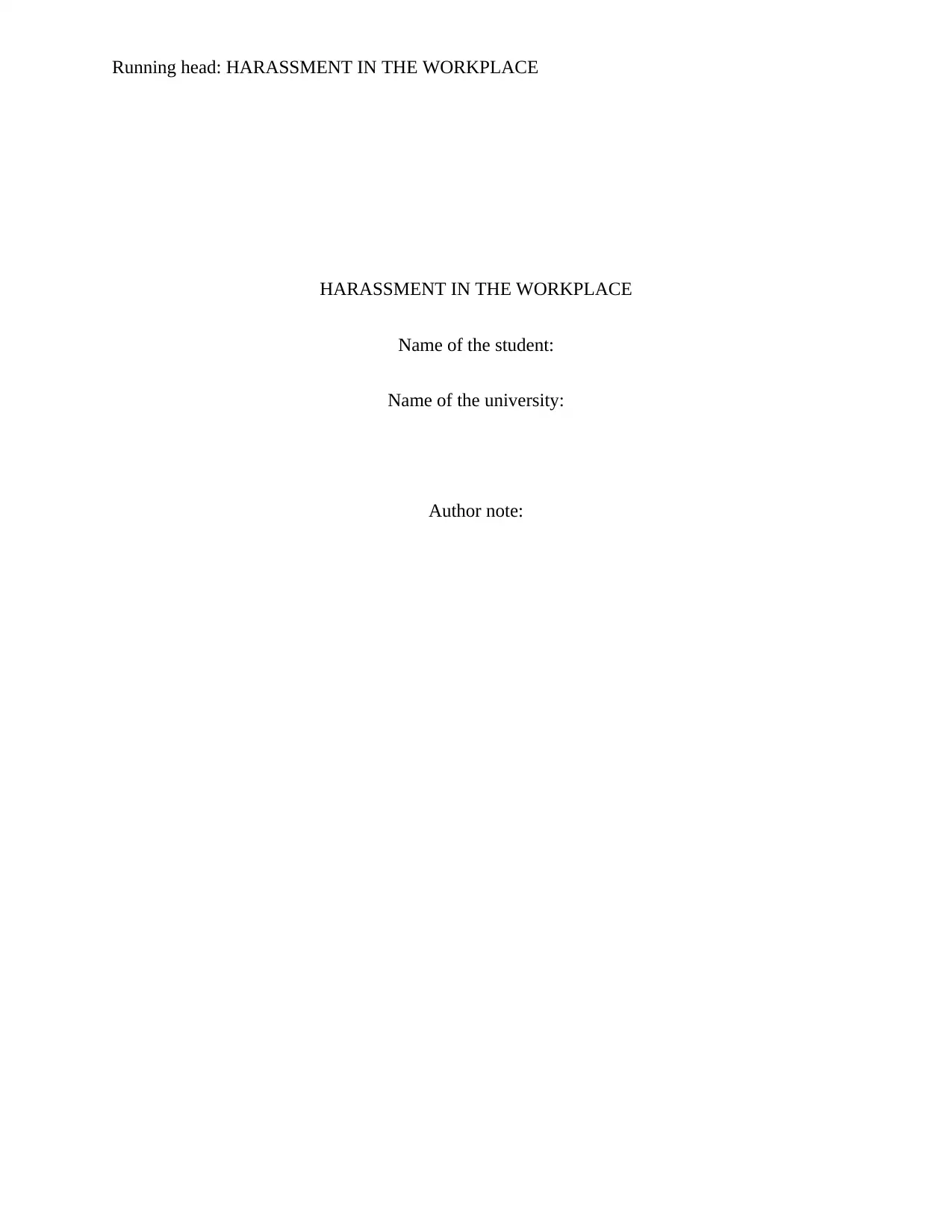
Running head: HARASSMENT IN THE WORKPLACE
HARASSMENT IN THE WORKPLACE
Name of the student:
Name of the university:
Author note:
HARASSMENT IN THE WORKPLACE
Name of the student:
Name of the university:
Author note:
Paraphrase This Document
Need a fresh take? Get an instant paraphrase of this document with our AI Paraphraser
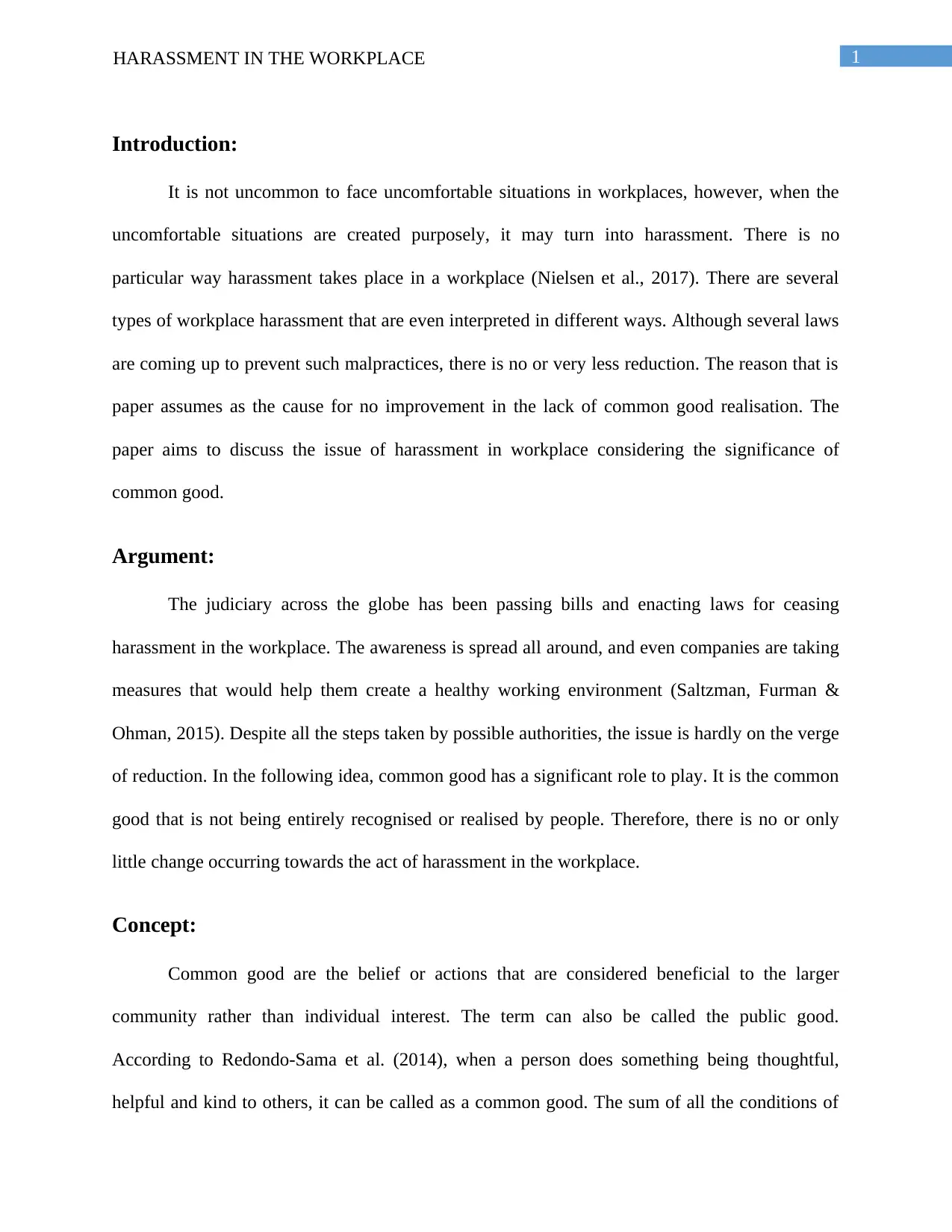
1HARASSMENT IN THE WORKPLACE
Introduction:
It is not uncommon to face uncomfortable situations in workplaces, however, when the
uncomfortable situations are created purposely, it may turn into harassment. There is no
particular way harassment takes place in a workplace (Nielsen et al., 2017). There are several
types of workplace harassment that are even interpreted in different ways. Although several laws
are coming up to prevent such malpractices, there is no or very less reduction. The reason that is
paper assumes as the cause for no improvement in the lack of common good realisation. The
paper aims to discuss the issue of harassment in workplace considering the significance of
common good.
Argument:
The judiciary across the globe has been passing bills and enacting laws for ceasing
harassment in the workplace. The awareness is spread all around, and even companies are taking
measures that would help them create a healthy working environment (Saltzman, Furman &
Ohman, 2015). Despite all the steps taken by possible authorities, the issue is hardly on the verge
of reduction. In the following idea, common good has a significant role to play. It is the common
good that is not being entirely recognised or realised by people. Therefore, there is no or only
little change occurring towards the act of harassment in the workplace.
Concept:
Common good are the belief or actions that are considered beneficial to the larger
community rather than individual interest. The term can also be called the public good.
According to Redondo-Sama et al. (2014), when a person does something being thoughtful,
helpful and kind to others, it can be called as a common good. The sum of all the conditions of
Introduction:
It is not uncommon to face uncomfortable situations in workplaces, however, when the
uncomfortable situations are created purposely, it may turn into harassment. There is no
particular way harassment takes place in a workplace (Nielsen et al., 2017). There are several
types of workplace harassment that are even interpreted in different ways. Although several laws
are coming up to prevent such malpractices, there is no or very less reduction. The reason that is
paper assumes as the cause for no improvement in the lack of common good realisation. The
paper aims to discuss the issue of harassment in workplace considering the significance of
common good.
Argument:
The judiciary across the globe has been passing bills and enacting laws for ceasing
harassment in the workplace. The awareness is spread all around, and even companies are taking
measures that would help them create a healthy working environment (Saltzman, Furman &
Ohman, 2015). Despite all the steps taken by possible authorities, the issue is hardly on the verge
of reduction. In the following idea, common good has a significant role to play. It is the common
good that is not being entirely recognised or realised by people. Therefore, there is no or only
little change occurring towards the act of harassment in the workplace.
Concept:
Common good are the belief or actions that are considered beneficial to the larger
community rather than individual interest. The term can also be called the public good.
According to Redondo-Sama et al. (2014), when a person does something being thoughtful,
helpful and kind to others, it can be called as a common good. The sum of all the conditions of
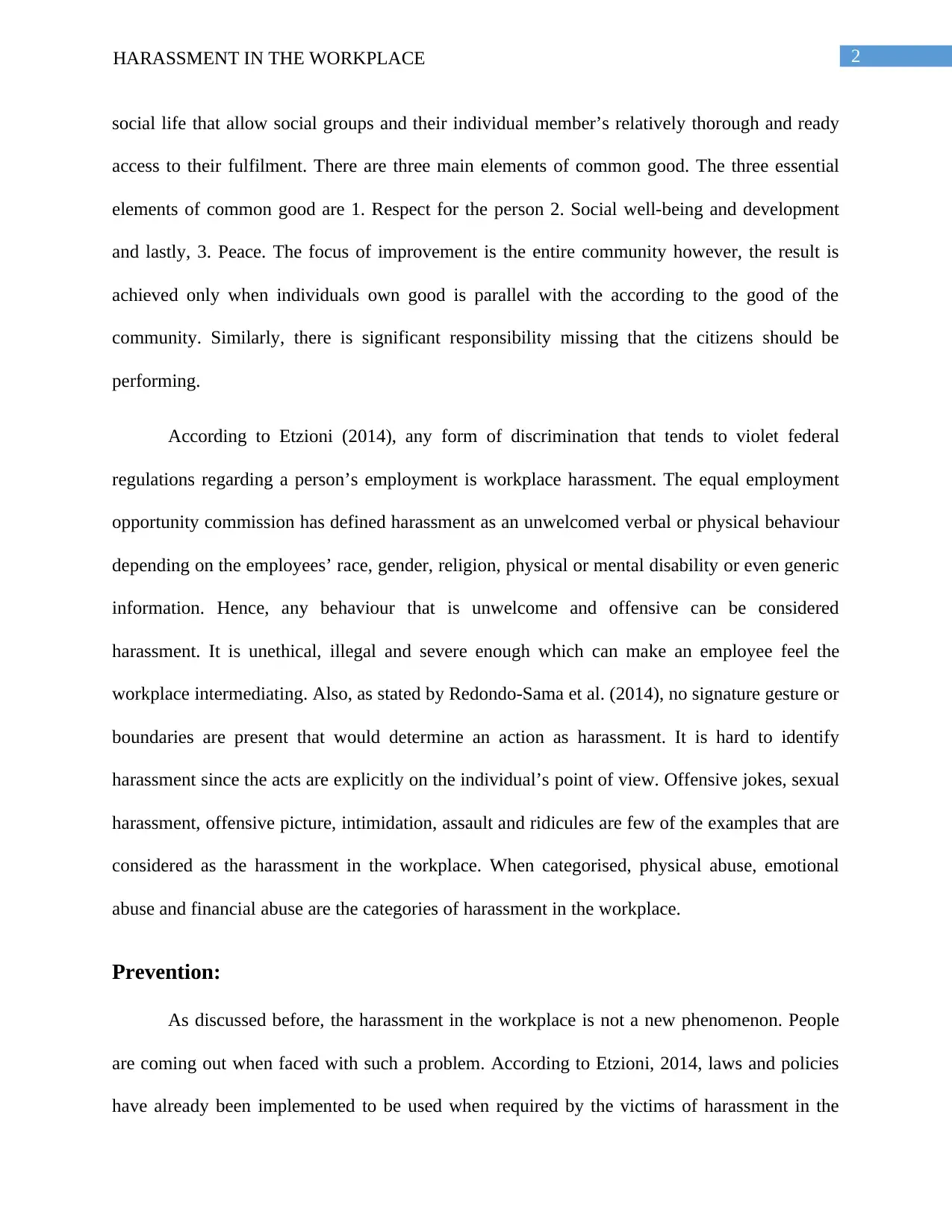
2HARASSMENT IN THE WORKPLACE
social life that allow social groups and their individual member’s relatively thorough and ready
access to their fulfilment. There are three main elements of common good. The three essential
elements of common good are 1. Respect for the person 2. Social well-being and development
and lastly, 3. Peace. The focus of improvement is the entire community however, the result is
achieved only when individuals own good is parallel with the according to the good of the
community. Similarly, there is significant responsibility missing that the citizens should be
performing.
According to Etzioni (2014), any form of discrimination that tends to violet federal
regulations regarding a person’s employment is workplace harassment. The equal employment
opportunity commission has defined harassment as an unwelcomed verbal or physical behaviour
depending on the employees’ race, gender, religion, physical or mental disability or even generic
information. Hence, any behaviour that is unwelcome and offensive can be considered
harassment. It is unethical, illegal and severe enough which can make an employee feel the
workplace intermediating. Also, as stated by Redondo-Sama et al. (2014), no signature gesture or
boundaries are present that would determine an action as harassment. It is hard to identify
harassment since the acts are explicitly on the individual’s point of view. Offensive jokes, sexual
harassment, offensive picture, intimidation, assault and ridicules are few of the examples that are
considered as the harassment in the workplace. When categorised, physical abuse, emotional
abuse and financial abuse are the categories of harassment in the workplace.
Prevention:
As discussed before, the harassment in the workplace is not a new phenomenon. People
are coming out when faced with such a problem. According to Etzioni, 2014, laws and policies
have already been implemented to be used when required by the victims of harassment in the
social life that allow social groups and their individual member’s relatively thorough and ready
access to their fulfilment. There are three main elements of common good. The three essential
elements of common good are 1. Respect for the person 2. Social well-being and development
and lastly, 3. Peace. The focus of improvement is the entire community however, the result is
achieved only when individuals own good is parallel with the according to the good of the
community. Similarly, there is significant responsibility missing that the citizens should be
performing.
According to Etzioni (2014), any form of discrimination that tends to violet federal
regulations regarding a person’s employment is workplace harassment. The equal employment
opportunity commission has defined harassment as an unwelcomed verbal or physical behaviour
depending on the employees’ race, gender, religion, physical or mental disability or even generic
information. Hence, any behaviour that is unwelcome and offensive can be considered
harassment. It is unethical, illegal and severe enough which can make an employee feel the
workplace intermediating. Also, as stated by Redondo-Sama et al. (2014), no signature gesture or
boundaries are present that would determine an action as harassment. It is hard to identify
harassment since the acts are explicitly on the individual’s point of view. Offensive jokes, sexual
harassment, offensive picture, intimidation, assault and ridicules are few of the examples that are
considered as the harassment in the workplace. When categorised, physical abuse, emotional
abuse and financial abuse are the categories of harassment in the workplace.
Prevention:
As discussed before, the harassment in the workplace is not a new phenomenon. People
are coming out when faced with such a problem. According to Etzioni, 2014, laws and policies
have already been implemented to be used when required by the victims of harassment in the
⊘ This is a preview!⊘
Do you want full access?
Subscribe today to unlock all pages.

Trusted by 1+ million students worldwide
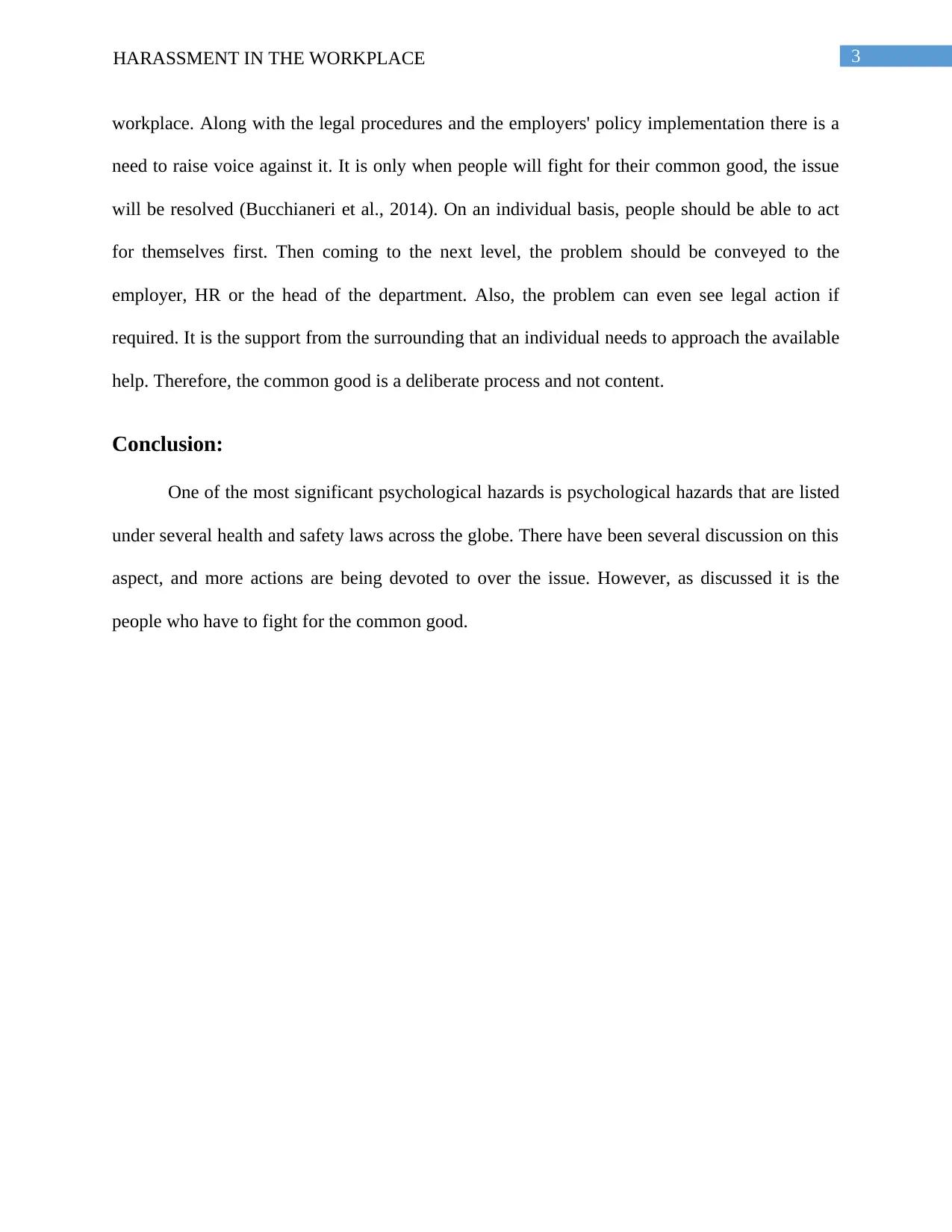
3HARASSMENT IN THE WORKPLACE
workplace. Along with the legal procedures and the employers' policy implementation there is a
need to raise voice against it. It is only when people will fight for their common good, the issue
will be resolved (Bucchianeri et al., 2014). On an individual basis, people should be able to act
for themselves first. Then coming to the next level, the problem should be conveyed to the
employer, HR or the head of the department. Also, the problem can even see legal action if
required. It is the support from the surrounding that an individual needs to approach the available
help. Therefore, the common good is a deliberate process and not content.
Conclusion:
One of the most significant psychological hazards is psychological hazards that are listed
under several health and safety laws across the globe. There have been several discussion on this
aspect, and more actions are being devoted to over the issue. However, as discussed it is the
people who have to fight for the common good.
workplace. Along with the legal procedures and the employers' policy implementation there is a
need to raise voice against it. It is only when people will fight for their common good, the issue
will be resolved (Bucchianeri et al., 2014). On an individual basis, people should be able to act
for themselves first. Then coming to the next level, the problem should be conveyed to the
employer, HR or the head of the department. Also, the problem can even see legal action if
required. It is the support from the surrounding that an individual needs to approach the available
help. Therefore, the common good is a deliberate process and not content.
Conclusion:
One of the most significant psychological hazards is psychological hazards that are listed
under several health and safety laws across the globe. There have been several discussion on this
aspect, and more actions are being devoted to over the issue. However, as discussed it is the
people who have to fight for the common good.
Paraphrase This Document
Need a fresh take? Get an instant paraphrase of this document with our AI Paraphraser
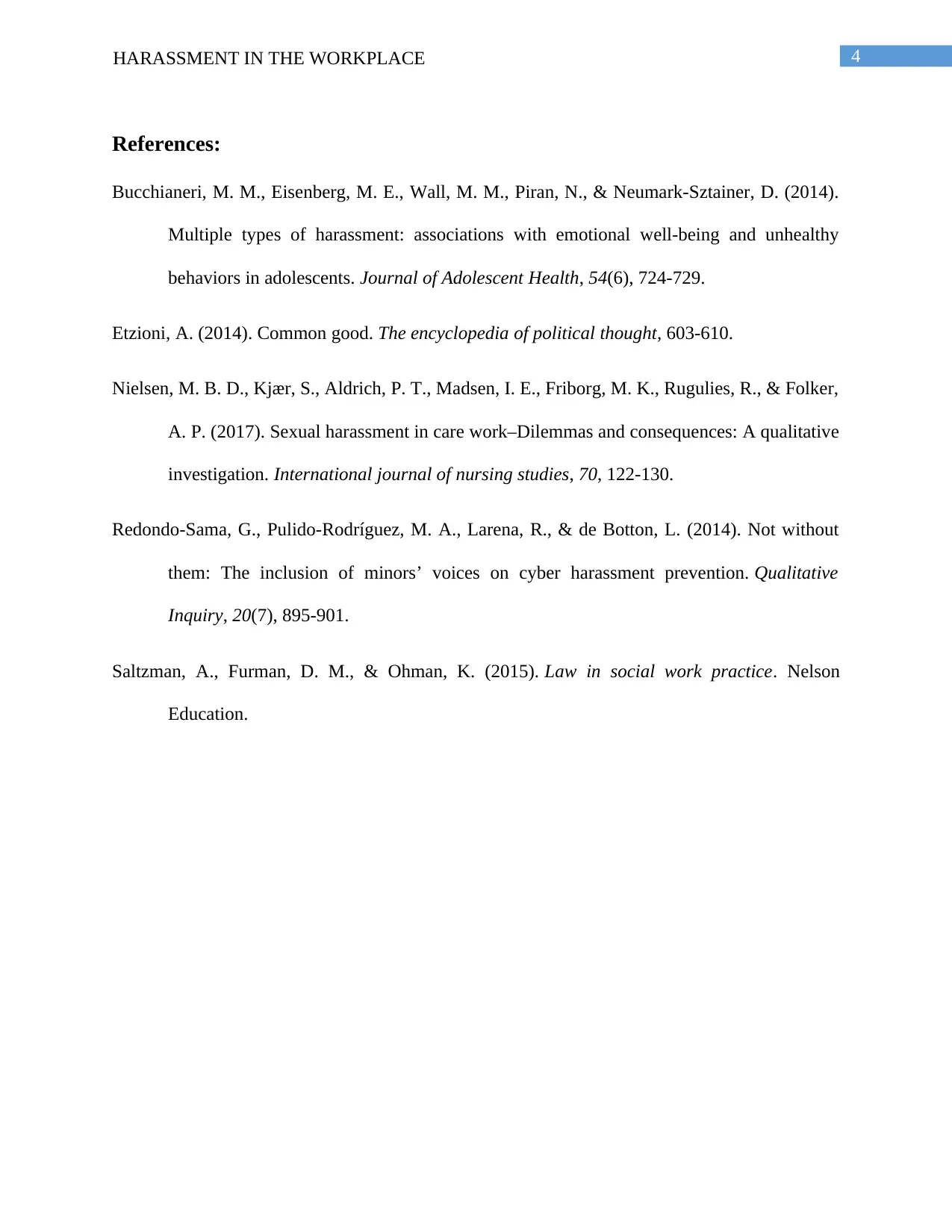
4HARASSMENT IN THE WORKPLACE
References:
Bucchianeri, M. M., Eisenberg, M. E., Wall, M. M., Piran, N., & Neumark-Sztainer, D. (2014).
Multiple types of harassment: associations with emotional well-being and unhealthy
behaviors in adolescents. Journal of Adolescent Health, 54(6), 724-729.
Etzioni, A. (2014). Common good. The encyclopedia of political thought, 603-610.
Nielsen, M. B. D., Kjær, S., Aldrich, P. T., Madsen, I. E., Friborg, M. K., Rugulies, R., & Folker,
A. P. (2017). Sexual harassment in care work–Dilemmas and consequences: A qualitative
investigation. International journal of nursing studies, 70, 122-130.
Redondo-Sama, G., Pulido-Rodríguez, M. A., Larena, R., & de Botton, L. (2014). Not without
them: The inclusion of minors’ voices on cyber harassment prevention. Qualitative
Inquiry, 20(7), 895-901.
Saltzman, A., Furman, D. M., & Ohman, K. (2015). Law in social work practice. Nelson
Education.
References:
Bucchianeri, M. M., Eisenberg, M. E., Wall, M. M., Piran, N., & Neumark-Sztainer, D. (2014).
Multiple types of harassment: associations with emotional well-being and unhealthy
behaviors in adolescents. Journal of Adolescent Health, 54(6), 724-729.
Etzioni, A. (2014). Common good. The encyclopedia of political thought, 603-610.
Nielsen, M. B. D., Kjær, S., Aldrich, P. T., Madsen, I. E., Friborg, M. K., Rugulies, R., & Folker,
A. P. (2017). Sexual harassment in care work–Dilemmas and consequences: A qualitative
investigation. International journal of nursing studies, 70, 122-130.
Redondo-Sama, G., Pulido-Rodríguez, M. A., Larena, R., & de Botton, L. (2014). Not without
them: The inclusion of minors’ voices on cyber harassment prevention. Qualitative
Inquiry, 20(7), 895-901.
Saltzman, A., Furman, D. M., & Ohman, K. (2015). Law in social work practice. Nelson
Education.
1 out of 5
Related Documents
Your All-in-One AI-Powered Toolkit for Academic Success.
+13062052269
info@desklib.com
Available 24*7 on WhatsApp / Email
![[object Object]](/_next/static/media/star-bottom.7253800d.svg)
Unlock your academic potential
Copyright © 2020–2025 A2Z Services. All Rights Reserved. Developed and managed by ZUCOL.





